No CrossRef data available.
Article contents
Ayumi Miura . Middle English verbs of emotion and impersonal constructions: Verb meaning and syntax in diachrony (Oxford Studies in the History of English). Oxford: Oxford University Press, 2015. Pp xvii + 290. ISBN 978-0-19-994715-7.
Review products
Ayumi Miura . Middle English verbs of emotion and impersonal constructions: Verb meaning and syntax in diachrony (Oxford Studies in the History of English). Oxford: Oxford University Press, 2015. Pp xvii + 290. ISBN 978-0-19-994715-7.
Published online by Cambridge University Press: 05 July 2016
Abstract
An abstract is not available for this content so a preview has been provided. Please use the Get access link above for information on how to access this content.

- Type
- Reviews
- Information
- Copyright
- Copyright © Cambridge University Press 2016
References
Carroll, Ruth. 1997. Cooking verbs in fourteenth-century English: A semantic class and its syntactic behaviour. D.Phil. thesis, University of Oxford.Google Scholar
Denison, David.
1990. The Old English impersonals revived. In Adamson, Sylvia M., Law, Vivien A., Vincent, Nigel & Wright, Susan (eds.), Papers from the 5th International Conference on English Historical Linguistics (Current Issues in Linguistic Theory 65), 111–40. Amsterdam: John Benjamins.Google Scholar
Diller, Hans-Jürgen. 2008. A lexical field takes shape: The use of corpora and thesauri in historical semantics. Anglistik: International Journal of English Studies
19
(1), 123–40.Google Scholar
Hopper, Paul & Thompson, Sandra. 1980. Transitivity and discourse. Language
56
(2), 251–99.Google Scholar
Levin, Beth. 1993. English verb classes and alternations: A preliminary investigation. Chicago: University of Chicago Press.Google Scholar
McCawley, Noriko A.
1976. From OE/ME ‘impersonal’ to ‘personal’ constructions: What is a ‘subject-less’ S? In Steever, Sanford B., Walker, Carol A. & Mufwene, Salikoko S. (eds.), Papers form the Parasession on Diachronic Syntax, April 22, 1976, 192–204. Chicago: Chicago Linguistic Society.Google Scholar
Méndez-Naya, Belén & López-Couso, María José. 1997. What is really meant by impersonal? On impersonal and related terms. Atlantis
19
(2), 185–92.Google Scholar
Möhlig-Falke, Ruth. 2012. The early English impersonal construction: An analysis of verbal and constructional meaning (Oxford Studies in the History of English). New York: Oxford University Press.Google Scholar



